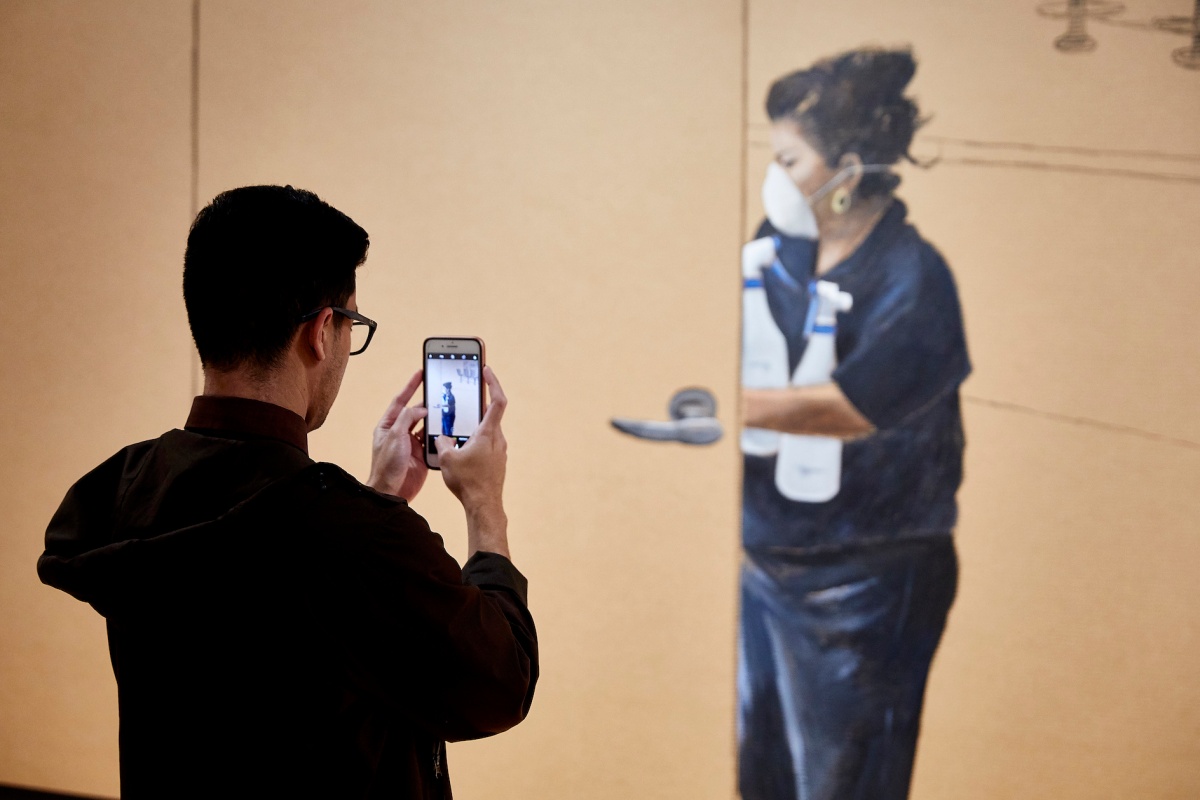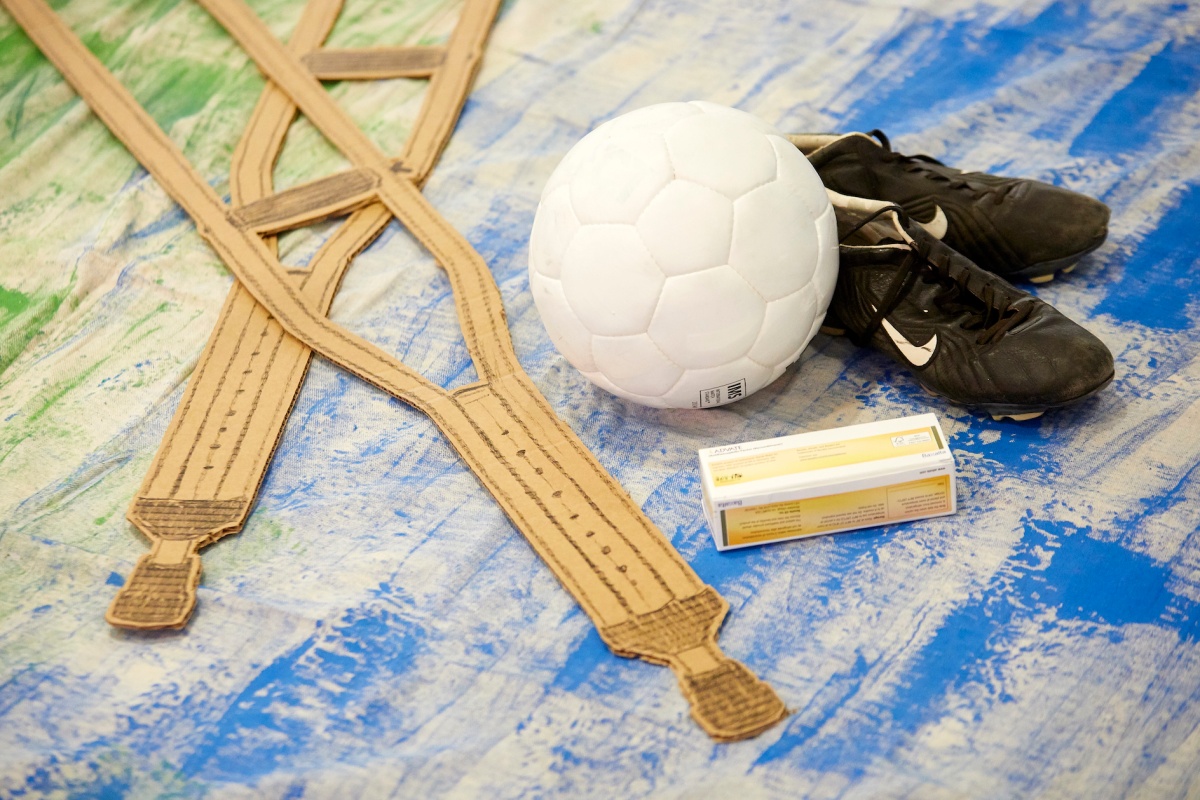
Barrick volunteer Michael Freborg has been thinking about Sorry for the Mess. (Have we mentioned before that he has a Bachelor of Arts in Communication Studies? He does.) He writes:
To me, one of the most fascinating aspects of any new exhibition is not the art itself, but the stories behind it. Sometimes artists include small Easter Eggs that reveal more about their works than what is on the surface. It might be personal information like their cultural background or life experiences. Or it could be references to people who have influenced them in some way. This inspiration may come from different sources, such as the films and television shows they have seen, sporting activities they were involved in, or geographical locations they have visited.
Maybe they want to make a statement about the world or use their art to prove a point. Perhaps their goal is to recreate events from their past. Or they might want to honor someone deserving of merit. Whatever the reason, the stories that linger behind the artwork are often intriguing. And in the Marjorie Barrick Museum’s latest exhibition, Sorry for the Mess, the art on display has stories worth telling. In their first-ever collaboration, Justin Favela and Ramiro Gomez bring some of their childhood memories to life, referencing both pop culture and everyday life in Las Vegas. Using painted imagery and three-dimensional installations, they not only pay tribute to family members, but to other working-class immigrants who toil at their jobs every day in our bustling 24-hour city. Their works are spread throughout the gallery like random memories that pop up out of the blue. They are large and painted in vibrant colors, as if seen through the eyes of children. And with the use of conventional paper, paint, and cardboard, these artists prove that you don’t need fancy materials to make meaningful art.
It is the layers of meaning beneath the paint and the crinkled-up paper that make this exhibition so fascinating. There is the soccer field with the carefully placed crutches before the goal, symbolizing Gomez’s perseverance playing in Las Vegas tournaments during his youth despite his struggle with hemophilia. There are the fluorescent-colored tire stacks reminding me of all the automotive repair shops in town, as well as all the potholes and sharp piercing objects that plague the roads in our valley. The tire installation is a homage to the Swiss artist Ugo Rondinone’s Seven Magic Mountains, a series of totems made with stacked colored boulders located near Interstate 15 south of Las Vegas. And it is one of several instances where Favela recreates blue-chip art with basic household materials.
A central theme of the exhibition is how kids formulate their ideas about the world from their television screens. From the perspective of younger viewers, television images are often big and bright and spectacular. Favela strives to capture this idea in one of his larger sculptures, a structure that looks like a giant parade float made with colorful piñata fringe. Big Bird’s skinny orange legs and big three-toed feet sprawled out in a gesture of fatigue are hard to miss. The yellow-feathered bird and other life-size Sesame Street characters, including the mighty Snuffleupagus, are piled atop each other in the shape of the Luxor pyramid. The work is a nod to both the iconic Las Vegas casino and the preschoolers who may have gotten their first taste of the English language from the popular children’s T.V. show. (Both Favela and Gomez are first-generation Americans.)
The characters look as if they are all passed out from a long day of on-camera acting. By reminding us that Muppets have their own form of labor, Favela has connected these television icons to the human workers represented elsewhere in Sorry for the Mess, encouraging us to think of work as a broadly resonant category.

This television motif reverberates throughout the exhibition. The diorama in the center gallery is an interior reproduction of Favela’s grandmother’s house, complete with painted furniture and crayon-colored windows created by Gomez. The artists include cardboard television cameras mounted on tripods inside the faux residence. The collaborative display is inspired by La science des rêves (The Science of Sleep), a 2006 surrealistic fantasy film by French filmmaker Michael Gondry. The story revolves around a distraught graphic artist named Stéphane who has difficulty distinguishing between his own fantasy world and the real one he physically occupies. The mock cameras are a reference to dream sequences in which Stéphane’s home becomes a television production studio and Stéphane demonstrates “how dreams are made,” as if he is on a cooking show. One half of this installation mimics the studio in Sleep, while the other half shows us the dream – a field of childlike scribbles – projected onto the television in the grandmother’s living room.
Here, Favela and Gomez demonstrate their own “dream-making” with the use of cardboard, paint, and crayons, paying tribute to the domestic artistry of Favela’s grandmother and highlighting the intersection of fantasy and reality that permeates Mess. The whole exhibition feels like a wakeful dream, occupying a space between two worlds, while never truly crossing over into either one.
Like Stéphane’s mind in the film, Sorry for the Mess is strewn with objects that teeter between dreams and reality. This is most evident in the scale of some of the artwork. As visitors wander through the gallery, they will notice all the “wet floor” signs, ranging from very tiny to one big enough to walk under. The larger ones seem to symbolize how people blow things out of proportion. But they are also exaggerated in size to draw attention. With these big yellow A-frames, Favela and Gomez hope to shine a spotlight on the “invisible” blue-collar workers who are taken for granted, ignored, or sometimes not even noticed by the patrons they serve or the casual passersby too preoccupied with their own daily routines. Along with the T.V. studio motif, this theme dominates the exhibition.
Examples are easy to find. Next to the Muppets is a white statue as tall as the wall behind it. The polystyrene sculpture, with its outline framed in cardboard, is based on one of three female figures adorning The Three Graces Fountain inside Caesars Palace. Beside it, a cardboard casino employee painted by Gomez maneuvers an industrial-grade vacuum cleaner plugged into a socket near the bottom of one of the statue’s legs. Colorful paintings by the same artist are scattered throughout the gallery, each commemorating the unsung laborers who diligently wait restaurant tables, empty trash receptacles in food courts, and clean hotel rooms and casino floors in the town that never sleeps.
Near the statue and its vacuuming worker is a dolphin sculpture enclosed in an open wood frame structure resembling an aquarium. If there is a single piece in the gallery with the most backstory, it is certainly this one. It’s a reference to a high-priced piece of artwork and a homage to an animal attraction at one of Las Vegas’s most famous resorts. It also acknowledges a bit of UNLV’s controversial history and alludes to giant sea-dwelling creatures that swam across Nevada’s ocean-covered prehistoric desert.
The work is based on Duchess, the oldest dolphin and matriarch at Siegfried & Roy’s Secret Garden and Dolphin Habitat at the Mirage Hotel. On the wall opposite the sculpture, Gomez has painted a portrait of the Habitat’s head dolphin supervisor, Erica Kiewice, overlapping a blown-up representation of a detail from The Mirage’s carpet made of piñata paper. The “water tank” encasing Favela’s dolphin is an allusion to Damien Hirst’s art piece, The Unknown (Explored, Explained, Exploded), a 13-foot submerged tiger shark that hovers in three segmented steel and glass tanks over The Unknown Bar in the lobby of the Palms Casino. It may also be a subtle reference to Favela’s mother, who has worked at the Palms since its opening in the early 2000s.
To make his sculpture, the artist covered wire netting with grey tissue paper, supporting it with a wooden frame underneath, as is typical of most of his larger three-dimensional works. Like many of the pieces in the exhibition, it was built in an on-campus studio, using simple materials. Again, he makes the point that anyone can create art, regardless of their economic status.
The location of the dolphin has significance. What makes Duchess so special in this exhibition is its placement on the floor over a depiction of UNLV’s earliest mascot, Beauregard, a winking, smirking, cartoonish-looking wolf dressed as a Confederate soldier. The university retired Beauregard in 1976 because students protested the racist connotation of the uniform. When the campus gymnasium became a university museum, the old image of the wolf at the center of the basketball court was covered up and forgotten under a giant ichthyosaur skeleton embedded in rock. It wasn’t until the fossil was deaccessioned that the sigil was rediscovered by museum staff.
Favela hints at the ichthyosaur with subtle details included in Duchess’s design. He made the “V” in the tail more indented than a normal dolphin tail and gave the head a much longer snout – both minor nods to the prehistoric bones that were once on display here. By repeating the historical relationship of Beauregard and the fossil, Favela proposes questions about the recurring nature of prejudice and the impossibility of erasing the past.
The ichthyosaur can be viewed, along with many other prehistoric bones, in the Nevada State Museum at Springs Preserve. As for Duchess the Dolphin, the paper sculpture, with its references to goofy-looking mascots and sea-dwelling beasts, blue-chip artwork and animal sanctuaries, will be on display with the rest of its counterparts at the Marjorie Barrick Museum of Art through August 3, 2019.

All of the photographs in this post were taken by Josh Hawkins/UNLV Creative Services